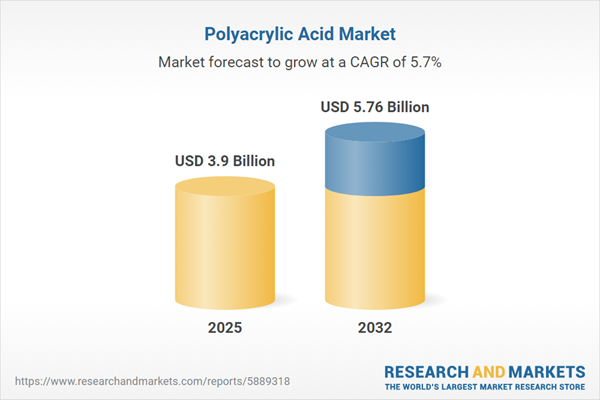Speak directly to the analyst to clarify any post sales queries you may have.
Senior executives operating in the polyacrylic acid market must address ongoing regulatory shifts, intensifying sector demand, and heightened competition. Effectively navigating these challenges requires advanced, proactive strategies—essential for promoting growth and ensuring resilience as the industry evolves.
Market Snapshot: Polyacrylic Acid Market Size, Growth, and Trajectory
The polyacrylic acid market demonstrates steady expansion, with forward trajectories forecasting further positive growth. This momentum is powered by manufacturers’ growing need for specialized additives across multiple industries, supporting a broader range of advanced applications. Sustainability and compliance initiatives are accelerating sectoral progress, with manufacturers instituting robust operational processes in response to more stringent regulation. Demand for polyacrylic acid continues to rise, prompting ongoing innovation and positioning the sector to deliver appreciable value across both legacy and emerging end uses.
Scope & Segmentation: Key Dimensions Influencing Polyacrylic Acid Market Analysis
- Form: Granules, liquids, and powders are available, allowing manufacturers to align supply formats with varied processing needs across industries such as water treatment, cleaning, and coatings.
- Molecular Weight: Options in high, medium, and low molecular weights enable tailored viscosity and solubility—critical for ensuring product suitability within diverse operational environments and application processes.
- Application: Polyacrylic acid is used in coatings and paints (for architectural and industrial projects), as well as in detergents and cleaning agents, oil and gas sector drilling fluids, and both municipal and industrial water treatment systems.
- Type: Copolymer and homopolymer types offer targeted solutions, supporting producers as they address unique performance, processing, and efficiency objectives.
- Geography: Market activity and opportunity are mapped across the Americas, Europe, Middle East and Africa, and Asia-Pacific, each with distinct sourcing, compliance, and supply chain dynamics.
- Key Companies: Sector innovation is shaped by leading market participants, including BASF SE, The Dow Chemical Company, SNF S.A.S., Evonik Industries AG, The Lubrizol Corporation, Arkema SA, Mitsubishi Chemical Corporation, LG Chem Ltd., Kuraray Co. Ltd., and Solvay SA.
Key Takeaways for Senior Market Decision-Makers
- Sustainability is advancing as a strategic imperative, with companies shifting toward solvent-free polymerization and utilizing bio-based raw materials to lower costs and meet rising benchmark standards throughout the value chain.
- Digital analytics and artificial intelligence are now pivotal, enabling more accurate demand forecasting and inventory management and contributing to stabilized supply networks and improved operational planning.
- Strategic research and development partnerships across industrial sectors are driving advanced polymer grade launches, delivering tailored solutions for essential end use cases such as high-performance coatings and water treatment.
- Global market volatility is leading organizations to diversify procurement, invest in regional manufacturing, and prioritize resilient supplier relationships, thereby reducing supply risk.
- Investment strategies increasingly rely on dependable access to raw materials and compliance with varying regional regulations, directly impacting site selection and distribution models.
- Growth strategies emphasize agile product innovation, digital process improvements, and customer-oriented approaches as organizations move beyond solely price-led competition for lasting market presence.
Tariff Impact: Navigating the U.S. 2025 Tariff Regime
The 2025 U.S. tariff adjustments are intensifying input cost pressures for domestic manufacturers and end-users in the polyacrylic acid supply chain. This has prompted a pronounced focus on local sourcing, revising long-term supply agreements, and expanding production capacity within the United States. As organizations adapt to these changes, procurement models are being reassessed and supplier partnerships strengthened. Distribution networks are being fortified to better safeguard pricing and supply continuity in an environment marked by ongoing policy fluctuations.
Methodology & Data Sources
This report’s insights are based on direct executive interviews, detailed supply chain surveys, and validated secondary research from patent records, regulatory documents, and established industry publications. Each finding has been cross-evaluated and peer reviewed to support informed and confident decision-making by market leaders.
Why This Report Matters for Strategic Polyacrylic Acid Decisions
- Empowers business leaders to anticipate and address emerging risks, while capitalizing on new opportunities brought by shifting industry dynamics.
- Provides comprehensive and sector-focused perspectives on regulatory updates, technology uptake, and evolving market priorities to support resource deployment and robust business planning.
- Delivers actionable regional analytics, supporting adaptation strategies for sourcing, compliance achievement, and focused growth aligned with specific local drivers.
Conclusion
Long-term viability in the polyacrylic acid market depends on leadership agility and the integration of informed, data-driven management approaches. Companies that prioritize technology innovation and understand regional nuances will reinforce their competitive position and deliver sustained value in the specialty chemicals landscape.
Additional Product Information:
- Purchase of this report includes 1 year online access with quarterly updates.
- This report can be updated on request. Please contact our Customer Experience team using the Ask a Question widget on our website.
Table of Contents
3. Executive Summary
4. Market Overview
7. Cumulative Impact of Artificial Intelligence 2025
List of Figures
Samples

LOADING...
Companies Mentioned
The key companies profiled in this Polyacrylic Acid market report include:- BASF SE
- The Dow Chemical Company
- SNF S.A.S.
- Evonik Industries AG
- The Lubrizol Corporation
- Arkema SA
- Mitsubishi Chemical Corporation
- LG Chem, Ltd.
- Kuraray Co., Ltd.
- Solvay SA
Table Information
| Report Attribute | Details |
|---|---|
| No. of Pages | 197 |
| Published | October 2025 |
| Forecast Period | 2025 - 2032 |
| Estimated Market Value ( USD | $ 3.9 Billion |
| Forecasted Market Value ( USD | $ 5.76 Billion |
| Compound Annual Growth Rate | 5.7% |
| Regions Covered | Global |
| No. of Companies Mentioned | 11 |









